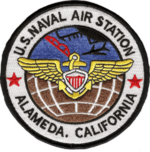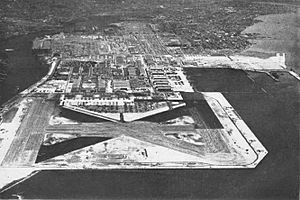Naval Air Station Alameda facts for kids
Quick facts for kids
Naval Air Station Alameda
 |
|||||||||||||||
|---|---|---|---|---|---|---|---|---|---|---|---|---|---|---|---|

Aerial view of NAS Alameda in the mid-1940s
|
|||||||||||||||
| Summary | |||||||||||||||
| Airport type | Military: Naval air station | ||||||||||||||
| Operator | United States Navy | ||||||||||||||
| Location | Alameda, California | ||||||||||||||
| In use | 1940 – 1997 | ||||||||||||||
| Coordinates | 37°47′10″N 122°19′07″W / 37.78611°N 122.31861°W | ||||||||||||||
| Runway | |||||||||||||||
|
|||||||||||||||
Naval Air Station Alameda (NAS Alameda) was a major U.S. Navy airport located in Alameda, California. It was built on the edge of San Francisco Bay and served as a very important base for naval aircraft for many years.
NAS Alameda had two main runways. One was about 8,000 feet (2,438 meters) long, and the other was about 7,200 feet (2,195 meters) long. It also had two special pads for helicopters and a control tower to guide planes.
Contents
Early Days and the China Clipper
Back in 1927, some wetlands on the west side of Alameda Island were filled in. This created land for a new airport called Alameda Airport. It had a runway, three hangars (buildings for airplanes), and a special harbor for yachts. This airport was also near the end of the First Transcontinental Railroad.
By 1930, the United States Army Air Corps started using the site, calling it Benton Field. Later, in 1935, Pan American World Airways used the yacht harbor for its famous China Clipper flights. These were the first regular passenger flights across the Pacific Ocean! The China Clipper terminal is now a California Historical Landmark.
On June 1, 1936, the city of Alameda, California gave the airport to the United States government. The Army stopped using the field soon after. Pan American World Airways moved its flights to Treasure Island in 1939.
In 1938, the government approved money to build a naval air station here. It was planned to support two aircraft carrier groups, five seaplane squadrons, and two utility squadrons. More money was added in 1940 to build two seaplane hangars and a pier where aircraft carriers could dock. Naval operations officially began on November 1, 1940.
World War II and Important Missions
After the attack on Pearl Harbor in December 1941, Fleet Air Wing 8 from Alameda started flying patrol and scouting missions. In April 1942, the aircraft carrier USS Hornet loaded 16 B-25 bombers at Alameda. These planes were used in the famous Doolittle Raid on Japan, a daring attack early in World War II.
From August to December 1944, Richard Nixon, who later became a U.S. President, was assigned to Fleet Air Wing 8 at Naval Air Station Alameda.
During World War II, Alameda was also a major training center. It had schools for radar operators, celestial navigation (using stars to find your way), and aviation storekeepers. NAS Alameda became the main base for many smaller auxiliary airfields in the region.
Cold War Era and Closure
Alameda remained a vital naval base throughout the Cold War. From 1949 to 1953, the Navy kept its largest airplane, the Lockheed R6V Constitution, at NAS Alameda. These huge planes regularly flew between nearby NAS Moffett Field and Pearl Harbor, Hawaii.
During the Vietnam War and after, several important aircraft carriers called NAS Alameda home. These included the Coral Sea, Hancock, Enterprise, USS Ranger, and Carl Vinson. The base also had a large facility called Naval Air Rework Facility (NARF) Alameda, later renamed Naval Aviation Depot (NADEP) Alameda. Thousands of civilian workers repaired and maintained aircraft there.
After 1961, NAS Alameda became a key center for Naval Air Reserve operations in northern California. Various Reserve squadrons were based there, flying different types of aircraft like the C-9 Skytrain II, KA-3 Skywarrior, A-6 Intruder, A-7 Corsair II, MH-53E Sea Dragon, SH-3 Sea King, A-4 Skyhawk, Sikorsky H-34 Sea Horse, CH-53 Sea Stallion, and P-2 Neptune.
The runways were made longer to handle jet aircraft. In 1967, the airfield was renamed Nimitz Field in honor of Fleet Admiral Chester W. Nimitz.
The base was eventually closed in 1997 as part of a program to reorganize military bases. Its runways were also closed and were not reopened for civilian flights.
What Happened After Closure?
After the base closed on April 25, 1997, the aircraft carrier USS Hornet was given to the former air station. It is now a museum ship called the USS Hornet Museum, where people can visit and learn about naval history.
The TV show MythBusters often used the runways at the former station for their vehicle experiments. This was because the long runways allowed them to set up a large, safe area for their tests. The location was also used for a car rally race called the Bullrun Rally.
A special two-mile freeway loop was built on the base for filming a long car chase scene in the movie The Matrix Reloaded. This loop cost over $1.5 million to build and was only used for the movie's chase scenes for seven weeks before it was taken down. You can still see where it was on some aerial maps.
Since 2000, the city of Alameda has been planning to redevelop the former Naval Air Station. This area is now known as Alameda Point. Redeveloping the area is complicated because of things like land rules, soil and water pollution, and wildlife protection areas.
Superfund Cleanup Site
NAS Alameda was listed as a Superfund cleanup site on July 22, 1999. A Superfund site is a place with hazardous waste that needs to be cleaned up. About 25 different spots on the base needed special cleanup. The largest of these spots was the West Beach Landfill, which is about 110 acres (44.5 hectares) in size. Tests showed that this landfill had polychlorinated biphenyl (PCB) contamination, which is a harmful chemical.
Images for kids




